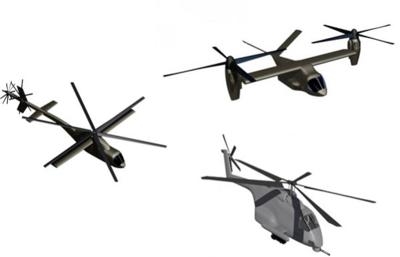Army Should Deliver Performance Specs This Summer
The military services expect to unveil performance specifications this summer for a new joint vertical-lift aircraft, Maj. Gen. William T. Crosby told congressmen. Crosby, director of the Army's Program Executive Office Aviation, testified Tuesday afternoon to the House Armed Services Committee, subcommittee on Tactical Air and Land Forces at a hearing on rotorcraft modernization programs. His counterparts from the Navy, Marine Corps and Air Force also testified.

Crosby said a consortium, which includes industry partners, has been working with the military on ideas for a joint vertical-lift aircraft. Two demonstrator aircraft have been developed, wind-tunnel tests have been conducted and other studies completed. He said a joint attack-utility variant is the first aircraft the military will invest in under the program. "Some people are saying it's going to be rotary-wing. We don't know that…" Crosby said. "It may be a tilt-rotor of some sort that we're going to go to. But based on the wind-tunnel studies and the demonstrators that we've done and the input of this team, including the consortium, we hope to have a deliverable this summer of a specification that will guide us toward what the next step will be that we're going after."
The effort to design a next-generation aircraft has been called the Joint Multi-Role program. This Army-led program has included input from the Office of the Secretary of Defense, all military services, including the Coast Guard, Special Operations Command, NASA, and others. Those involved envision the aircraft having vastly improved avionics, electronics, range, speed, propulsion, survivability, altitudes and payload capacity. Some have said it should be able to sustain speeds in excess of 170 knots, have an overall combat range greater than 800 kilometers and be able to hover with a full combat load at altitudes of 6,000 feet in 95-degree heat.
Under questions about industry reps being included in the consortium planning the aircraft, Crosby defended this partnership, stating the consortium has been primarily a technology advisory panel. "There was no commitment to award contracts of scope or anything like that," Crosby said. "What we were trying to preclude is duplication, where we had a bunch of people going after the same technologies. "The other thing is, we in the government, we don't do a lot of development, cutting-edge development. Our partners in industry, that's what they do. So we wanted to bring them on to look at these enabling technologies we needed to go to the future, to prevent us from going down a 'rat hole' and getting after something that really wasn't achievable."
The general said modernization is more of a challenge today because technology is turning over so fast. As science and technology dollars become tighter, the Army may rely more on consortiums to help develop new technologies for its future aircraft. A future vertical-lift study will soon be released to provide a way ahead for aviation modernization, Crosby said. "It lays out a roadmap for all of us services together looking forward. It identifies kind of a scalable architecture of rotary-wing or future vertical lift platforms."
Another program Crosby cited as showing a lot of potential is the Improved Turbine Engine Program, or ITEP. This program's objective is to develop technologies for a 3,000-horespower engine that reduces fuel consumption for the AH-64 Apache and UH-60 Black Hawk helicopters. "What a great capability," Crosby said of the ITEP tech demonstrators. He said they were demonstrating "all of the improvements that we're asking for," including a 30-percent increase in power and a 25-percent decrease in fuel.
The Improved Turbine Engine Program is expected to come out of its science and technology phase this summer, Crosby said, adding that the Army intends to continue carrying two vendors for the program if budget realities permit. (Image provided by the U.S. Army)
 ANN's Daily Aero-Term (04.24.24): Runway Lead-in Light System
ANN's Daily Aero-Term (04.24.24): Runway Lead-in Light System ANN's Daily Aero-Linx (04.24.24)
ANN's Daily Aero-Linx (04.24.24) Aero-FAQ: Dave Juwel's Aviation Marketing Stories -- ITBOA BNITBOB
Aero-FAQ: Dave Juwel's Aviation Marketing Stories -- ITBOA BNITBOB Classic Aero-TV: Best Seat in The House -- 'Inside' The AeroShell Aerobatic Team
Classic Aero-TV: Best Seat in The House -- 'Inside' The AeroShell Aerobatic Team Airborne Affordable Flyers 04.18.24: CarbonCub UL, Fisher, Affordable Flyer Expo
Airborne Affordable Flyers 04.18.24: CarbonCub UL, Fisher, Affordable Flyer Expo



